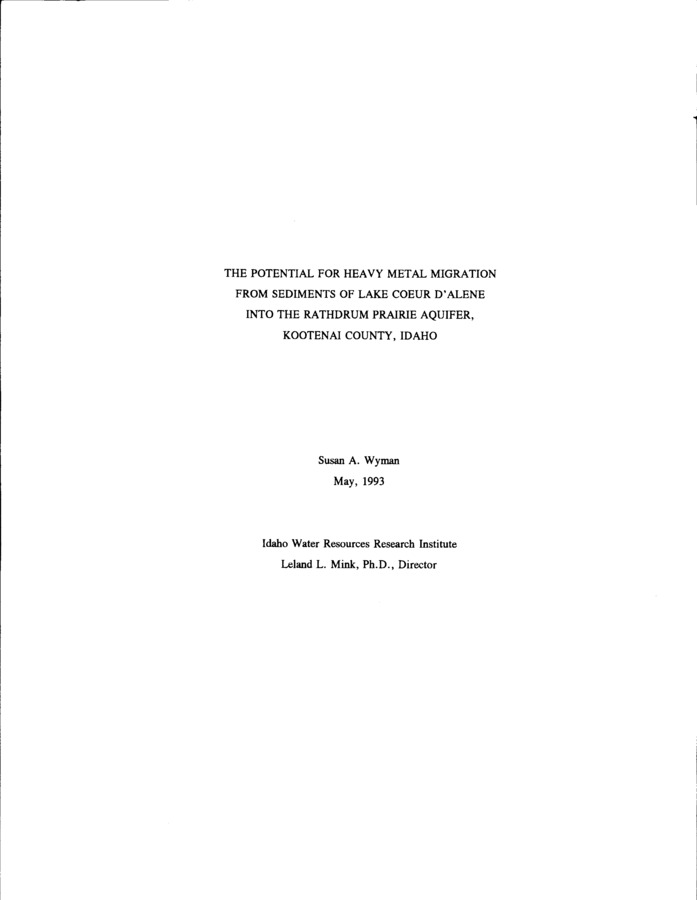PDF
Potential for heavy metal migration from sediments of Lake Coeur d'Alene into the Rathdrum Prairie aquifer, Kootenai County, Idaho; Research technical completion report Item Info
- Title:
- Potential for heavy metal migration from sediments of Lake Coeur d'Alene into the Rathdrum Prairie aquifer, Kootenai County, Idaho; Research technical completion report
- Authors:
- Wyman, Susan A.
- Contributors:
- Idaho Water Resources Research Institute; IWRRI; University of Idaho Department of Geology and Geological Engineering
- Date:
- 1993-11
- Description:
- The purpose of this project was to determine the potential for migration of heavy metals of Lake Coeur d'Alene into the Spokane Valley/Rathdrum Prairie Aquifer, as a result of changing lake chemistry caused by eutrophication. The upper sediment layers in Lake Coeur d'Alene are enriched in heavy metals and the lake appears to be becoming more eutrophic. The geologic history of the region contributes to the understanding of the hydrogeology of the study area. The coarse-grained glacial outwash aquifer is bounded below by fine-grained sediments of the Latah formation, and bounded laterally by Precambrian sediments and metasediments. A conceptual model for surface water/groundwater interaction reveals that the cross sectional area of the aquifer increases from the northern end of Lake Coeur d'Alene farther into the aquifer. This could account for the steep hydraulic gradient from the lake to the aquifer. The steep gradient could also be a result of fine sediments which have infiltrated the glacial outwash and have decreased the hydraulic conductivity of the aquifer, adjacent to the lake. Evidence for the infiltration of fine material exists in grain size analyses and unpublished reports. Lake Coeur d'Alene is dimictic and oligotrophic to eutrophic. Oxygen enrichment in the epilimnion and depletion in the hypolimnion are well-documented phenomena in eutrophic lakes. Dissolved oxygen concentrations as low as 52% were measured by the USGS northeast of Blue Point near Harrison in September, 1991. Anoxic, reducing conditions in the hypolimnion during summer stratification of the water column may cause Mn and Fe mobilization from sediments. Dissolved heavy metals in the hypolimnion are likely to coprecipitate with Mn oxyhydroxides (and to a lesser extent iron hydroxides) when the metals encounter more oxygenated water. Seismic profiles of the lake bottom indicate that fine, laminated sediments cover the central portions of the lake and thin out near the lake margins. These sediments contain elevated metals concentrations in both particulate form and in sediment pore water. The concentration gradient of metals in pore waters probably contributes to the upward migration of metals and the development of an enriched band of Fe, Mn and other trace metals in the sediment column. The band of Fe and Mn may reduce the concentration of trace metals in the water column (Sigg, 1987). The bulk of the water which moves from the lake into the aquifer during the summer "low flow" period leaves Lake Coeur d'Alene as underflow. The area through which most water moves is probably within 300 feet (90 m) of the shore, where fine, laminated lake bottom sediments are lacking. This zone is probably well oxygenated for most of the year. Analyses from four monitoring wells at the surface water-groundwater interface reveal that metal concentrations are elevated in groundwater. Concentrations of Fe and Mn exceeded EPA SMCLs in all four wells. Three wells exceeded EPA MCLs for selenium. Well AIP-2 exceeded EPA MCLs for As, Cd and Ph. Clay samples from the well were highly enriched in As, Co and Cu, but only slightly above average background concentrations in Fe, Mn, Zn, U, and Th. The concentrations of Pb, Ni, Sr, V, and Cr in clays were slightly below average background concentrations. Metal migration into the aquifer does not appear to be attenuated by ionic adsorption onto clay materials. Eutrophication may have positive benefits for metal removal from the water column, as algae and Mn adsorb and precipitate trace metals. This benefit may be offset by the reducing conditions and elevated pH which result from aphotic biological activity in the hypolimnion.
- Subjects:
- heavy metals eutrophication sediments
- Location:
- Rathdrum Prairie; Kootenai County, Idaho
- Idaho County:
- Kootenai County
- Latitude:
- 47.79
- Longitude:
- -116.86
- Collection:
- Coeur d'Alene Basin
- Series:
- Water for Idaho
- Source:
- Idaho Water Resources Research Institute, University of Idaho
- Identifier:
- IWRRI Number 199303
- Publisher:
- Idaho Water Resources Research Institute, University of Idaho
- Contributing Institution:
- University of Idaho
- Type:
- Text
- Format:
- application/pdf
- Cataloger:
- wbv
- Date Digitized:
- 2012
- Language:
- eng
Source
- Preferred Citation:
- "Potential for heavy metal migration from sediments of Lake Coeur d'Alene into the Rathdrum Prairie aquifer, Kootenai County, Idaho; Research technical completion report", Idaho Waters Digital Library, University of Idaho Library Digital Collections, https://www.lib.uidaho.edu/digital/iwdl/items/iwdl-cda_wyman_1993.html
Rights
- Rights:
- In copyright, educational use permitted. Educational use includes non-commercial reproduction of text and images in materials for teaching and research purposes. For other contexts beyond fair use, including digital reproduction, please contact the University of Idaho Library Special Collections and Archives Department at libspec@uidaho.edu. The University of Idaho Library is not liable for any violations of the law by users.
- Standardized Rights:
- http://rightsstatements.org/vocab/InC-EDU/1.0/

